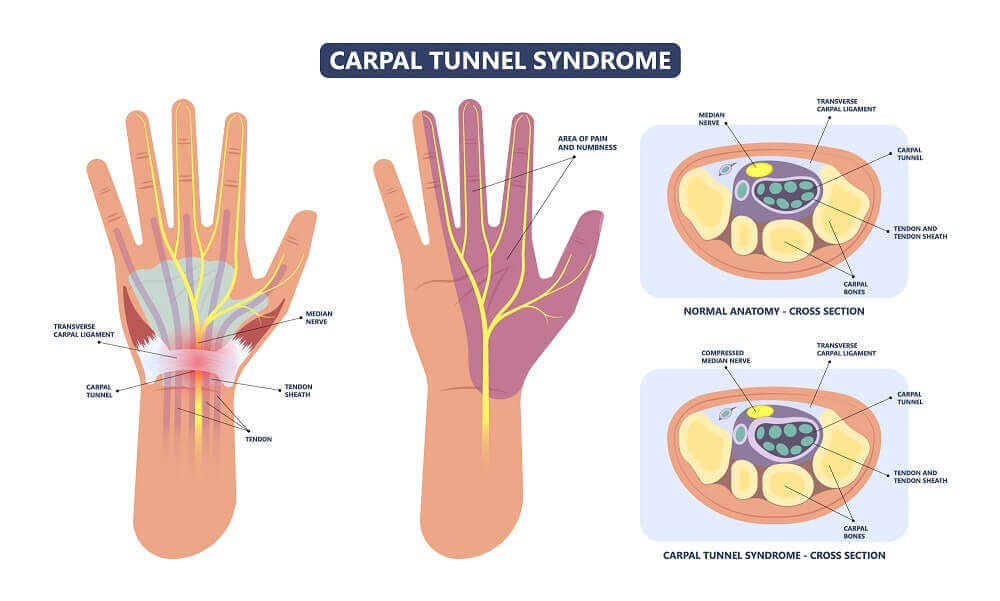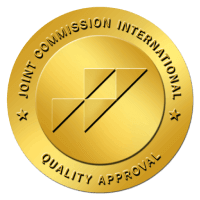CARPAL TUNNEL RELEASE SURGERY
Carpal tunnel release surgery is a procedure aimed at relieving pressure on the median nerve in the wrist, which can become compressed in individuals with carpal tunnel syndrome (CTS).
Anatomy of the Carpal Tunnel
- Location: Palm side of the wrist.
- Structure: Bounded by small wrist bones (carpals) and the transverse carpal ligament on top.
- Contents: Contains the flexor tendons (control finger movement) and the median nerve (provides sensation to most fingers).
What is Carpal Tunnel Syndrome?
Carpal Tunnel Syndrome occurs when the synovium swells narrowing the limited space within the tunnel and pinches the median nerve over time. The transverse carpal ligament can also become tight narrowing the carpal tunnel space and putting pressure on the median nerve.
- Result: Pain, tingling, or numbness in the hand and fingers.

- Risk Factors
- Diagnosis
- Treatment
The following factors have been known to increase a person’s risk of developing carpal tunnel syndrome:
- Repetitive Motion: Heavy, repetitive hand movements or prolonged gripping.
- Congenital: Naturally narrower carpal tunnels.
- Trauma: Wrist injuries like fractures or sprains.
- Hormonal Changes: Pregnancy, menopause, birth control pills or hormone pills are risk factors as they alter the levels of hormone in the body.
- Medical Conditions: Conditions such as hypothyroidism, rheumatoid arthritis, diabetes, obesity, gout, overactive pituitary gland, or the presence of a cyst or tumor extending to the carpal tunnel.
- Medical History & Physical Exam: Initial steps in identifying carpel tunnel syndrome.
- Diagnostic Tests:
- X-rays for bone issues.
- Blood tests to rule out conditions like diabetes or thyroid issues.
- Electrodiagnostic tests to assess nerve function.
- Conservative Methods:
- Treating underlying conditions (e.g., diabetes).
- Wearing splints or wrist braces for 4-6 weeks.
- Ice therapy to reduce swelling.
- Activity modification and pain management via medications or steroid injections.
- Physical therapy for strengthening and stretching.
- Surgical Intervention: Recommended if conservative treatments fail.
Carpal Tunnel Release Surgery
The goal of carpal tunnel release surgery is to reduce pressure on the median nerve by cutting the transverse carpal ligament, thereby enlarging the carpal tunnel.
Types of Surgery
- Endoscopic Carpal Tunnel Release:
- Minimally invasive technique where a thin tube with a camera (endoscope) is inserted through a small incision.
- Two techniques are commonly used:
- Single-Port Endoscopy: A single small incision is made at the wrist. Both the endoscope and cutting tool are introduced through the same port.
- Two-Port Endoscopy: Two small incisions are made—one at the wrist and one at the palm. The camera and cutting tools are inserted separately.
After visualizing the transverse carpal ligament with the endoscope, a small cutting tool is used to sever the ligament, releasing the pressure on the median nerve. The incisions are then closed with stitches.
- Open Carpal Tunnel Release:
- This more traditional method involves making a larger incision at the base of the palm to access the transverse carpal ligament directly.
- The ligament is then cut to relieve pressure on the median nerve.
In both methods, cutting the ligament allows scar tissue to develop, which creates more space for the median nerve and reduces compression.
POST-OPERATIVE CARE
Patient having carpal tunnel release surgery can be discharged home the same day.
Recovery Guidelines:
- Elevate the hand to reduce swelling.
- Wear a splint as recommended.
- Use ice packs on the surgical area.
- Keep the incision clean and dry (cover when showering).
- Physical therapy may be needed to regain strength.
- A healthy diet and no smoking help healing.
The majority of patients do not suffer any complications following carpal tunnel release surgery but as with any surgery, complications can occur and can include continued pain, infections, scarring, and nerve damage causing weakness, paralysis, or loss of sensation and stiffness in the hand and wrist area.












